
Amazing Samsung Induction Range YouTube Video
What is Induction Cooking?
An induction stove is a cooking appliance that uses electromagnetism to generate heat in pots and pans. It works by using an electromagnetic field to create eddy currents in the metal of the cookware, which in turn generates heat. This process is known as electromagnetic induction.
One of the main advantages of induction stoves is that they are highly efficient and can heat up pots and pans quickly. Because the heat is generated directly in the cookware, there is very little heat loss compared to other stovetop cooking methods. This means that less energy is required to achieve the desired cooking temperature, which can help to reduce energy consumption and save money on utility bills.
Induction stoves are also generally safer to use than gas or electric stoves. Because the heat is generated in the cookware rather than on the surface of the stove, there is a reduced risk of burns or fires. Additionally, the stove surface remains relatively cool to the touch, even when pots and pans are being heated, which makes it safer to use around children or pets.
Another advantage of induction stoves is that they are highly responsive, which means the temperature can be easily adjusted by turning a dial or pressing a button. This allows for precise temperature control and makes cooking a wide range of dishes easier.
There are some drawbacks to induction stoves as well. For example, they are generally more expensive than other types of stovetops and may require purchasing new cookware compatible with induction. In addition, they can produce a humming or buzzing noise when in use, which can be annoying to some users.
Despite these drawbacks, induction stoves have gained popularity recently due to their efficiency, safety, and precision. They are a popular choice for home cooks and professional chefs and will likely continue to be popular.
Looking for something to cook on your induction range? Try Amazon Fresh (sponsored link)
Why is this important?
The benefits of induction cooking are derived from direct heating. Less wasted heat goes into your kitchen or the stovetop. Instead, the heat goes into your food. Spills are less likely to burn when there is less heat on the stovetop. Kitchens are less likely to be overly hot in the summer when the heat is generated directly in the pan. The 220-volt voltage of the range allows for more current delivery to the induction elements. More current means that the induction element can generate a massive amount of heat in the pan in a short period. This massive build of heat means you can quickly boil water or sear food. Potential downsides to induction cooking may arise from non-ferrous (iron) pots and pans. Only materials containing iron can be heated with an induction stove. You can use an induction stove if a magnet sticks to your cookware. Aluminium, glass, copper, and ceramic are incompatible with an induction stove.
Compatible Cookware
Iron materials react best with an inductions stove. For example, a cast iron skillet will heat most efficiently. A stainless steel pan is slightly less efficient in heating. Aluminium pans are incompatible with an induction stove unless iron or steel is built into the bottom of the pan. Cookware must be flat to induce the most heat in the metal. Cookware with curves caused by warping may not contact the induction element either, leading to inefficient and uneven heating.
Since the heating comes from the pan itself, putting items under it, such as paper, baking sheets, and silicon fibreglass mats is possible. These mats can be used as a protective barrier. Baking sheets can serve as a method for quick cleanup. After the cooking, you may remove the baking sheet and the mess. These mats do have a limit on how much heat they can withstand. The high heat from high power settings or extended cooking can reach temperatures where the material will break down or smoulder and burn.
Applications
The range can connect to a wireless network, allowing for remote monitoring and control. The range possesses an intelligent control enablement selector to prevent tampering. This control limiter prevents the oven from activating without the owner’s consent or by accident. Someone must physically enable extended features for additional control. With the restriction, you can interrogate the range for temperature, status, and times and turn on the light in the range. You can turn the oven on to heat from many cooking modes when the switch is enabled. The connectivity allows one to switch off an unattended oven and monitor when events occur. For example, if you open the oven and put food in it but forget to start a timer, you can look back on the events on a phone or computer to see when you opened the door to determine how long the food has been cooking. You cannot control the cooktop since the cooktop settings are controlled with a physical knob. You can see what if the cooktop is on and what level (1-10) is currently set. The connectivity has an added benefit, and the network sets the clock. One less clock to set or correct! Smart speakers like Amazon Alexa and Google Nest are integrated with Samsung SmartThings software. You can use these smart speakers to turn on the oven, change the temperature, tell the current temperature, and more.
Transition Plans
Recently, a range I put in place in 2005 started to fail. The heat sensor on one of the elements failed to the on position. This failure did not impact the operation of the range, but it did cause a warning indicator light to illuminate constantly. Over time, a thermostat inside the range failed. The stove continued to function, but the oven would not heat. With this failure, I searched for an induction slide-in range with an air fryer and a convection fan. I purchased a Samsung Induction Stove Model code: NE63B8611SS/AA (link) online. The original range moved out of my home and took residence at a metal recycler.
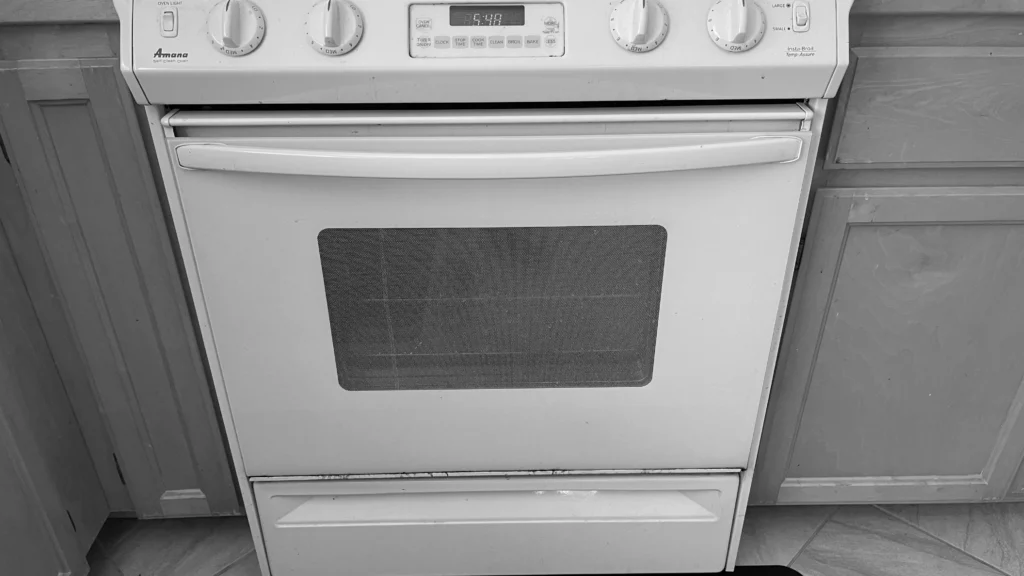
The online order would take some time to fulfil, and preparations were needed to get ready for the oven. Time was taken to inspect the 220-volt outlet for potential problems, and the area was cleaned. While waiting for the order to arrive, the original range’s glass top was separated from the rest of the range and left in place on the countertop.

An alternate method to cook was employed with a non-operational glass cooktop in place. A portable induction stove and a portable gas stove (link) were placed on the glass cooktop as a short-term cooking solution. The portable induction stove is something that we find to be very useful to take on road trips.
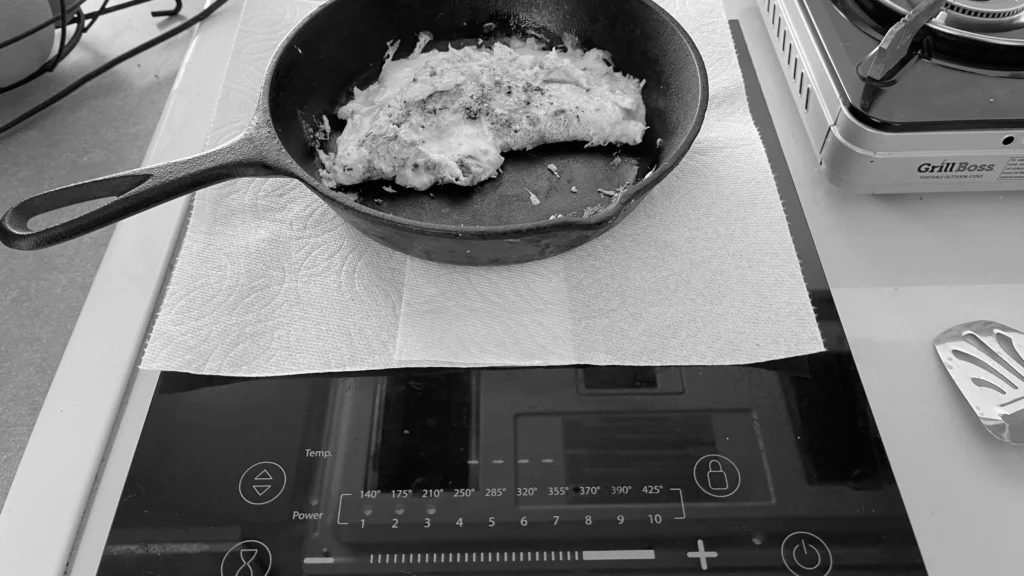
Arrival!
The range arrived on schedule, and it was time to install it. If you are unfamiliar, most ranges do not come with a plug. This range was quickly wired, tested and powered. Testing involved checking the continuity of the wiring, turning on the circuit breaker and testing voltages. All tests were a success. The circuit breaker was de-energized for safety while the wiring cover was replaced, and the range was put into position.

The range was replaced, the circuit breaker was re-energized, and the range was adjusted for level (front to back and left to right). Once the levelling adjustments were completed, the range was connected to an iPhone app, configured, time set, and tested. Success! The first test with this range was an omelette cooked in an iron skillet. With induction stovetops, the plan is heated electromagnetically. Instead of the stovetop getting hot, the induction directly heats the pan. As soon below, the pan is cooking an omelette and a paper towel is placed between the pan and the range. The pan’s heat is lower than the burning point of paper (230°C).

Protection
The glass cooktop is very sturdy and resistant to scratching. My previous cooktop never scratched over the 16 years of service with iron skillets, pots, and pans. With this range, extra precautions are being taken to avoid potential damage.
Silicon Mats
Silicon fibreglass pads are placed between the pan and the stovetop while cooking. My rule is to use the pads unless the stove is set to high or you cook for an extended time. The silicon fibreglass pads start to break down above 250°C. I stop using them when the stove is above levels 5 to 10 or when cooking lasts more than 30 minutes. In this case, the pan is carefully placed and not moved during cooking.
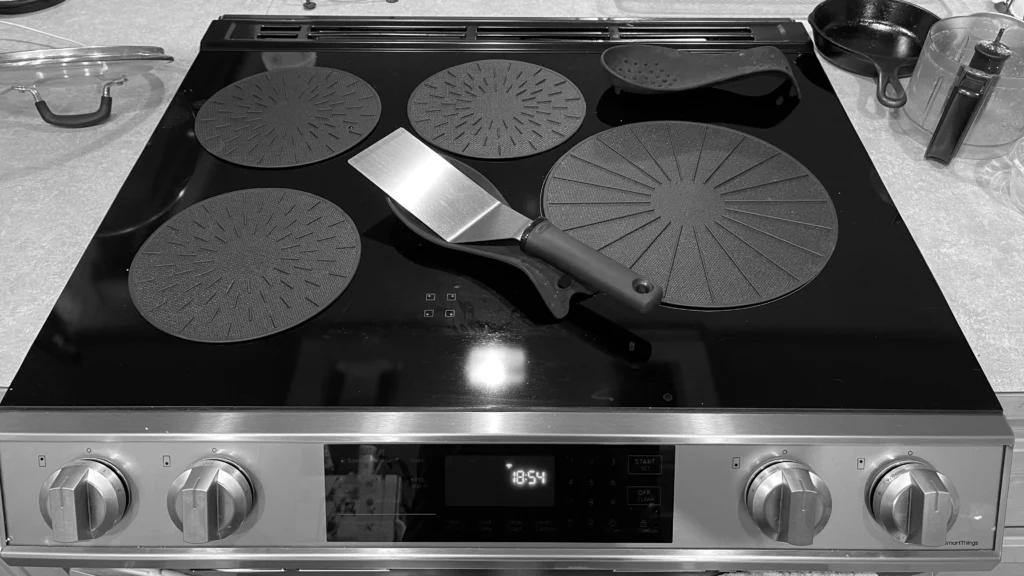
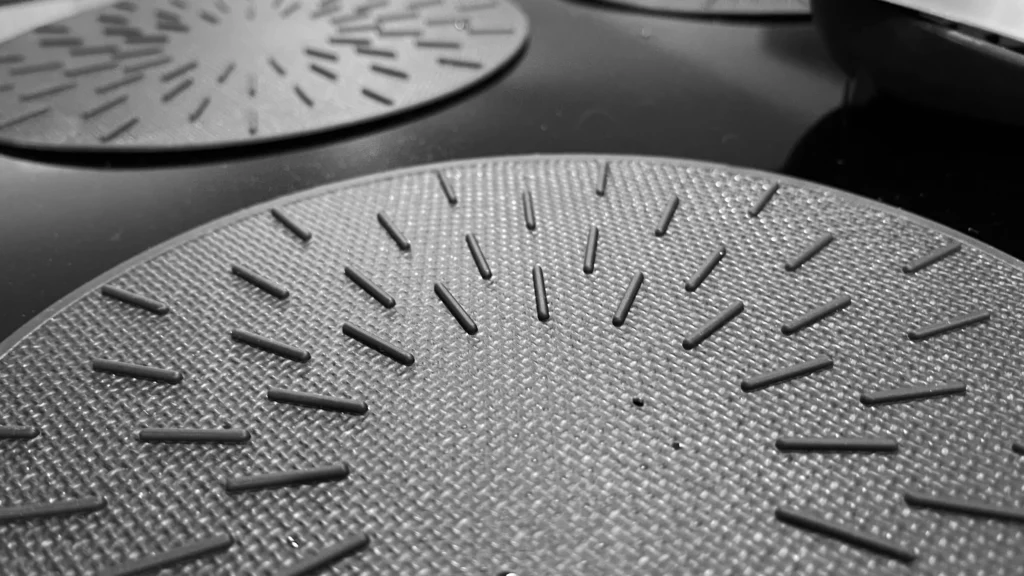
Parchment Paper
You may use parchment paper instead of silicon mats to protect the finish of your stove top while using cast iron cookware. The Maximum temperature of the parchment paper shown below is 215°C. You should be able to cook meals using lower power settings without worrying about the potential burning of the material. As a test, breakfast was cooked with 15 minutes of stovetop time. During the cooking, the pan surface reached a temperature of 197.7°C. Immediately after removing the pan, the parchment paper temperature was measured to be 145.5°C. Within seconds of removing the parchment paper from the cooktop, the measured temperature was 164.1°C. As shown, the pan is the hottest. The stovetop and the parchment paper do not reach the hottest temperature and cool rapidly when the cookware is removed from the stovetop. Parchment paper is not likely to burn if you do not cook at higher power levels or cook for extended periods. You should continually monitor cooking when using silicon mats or parchment paper.
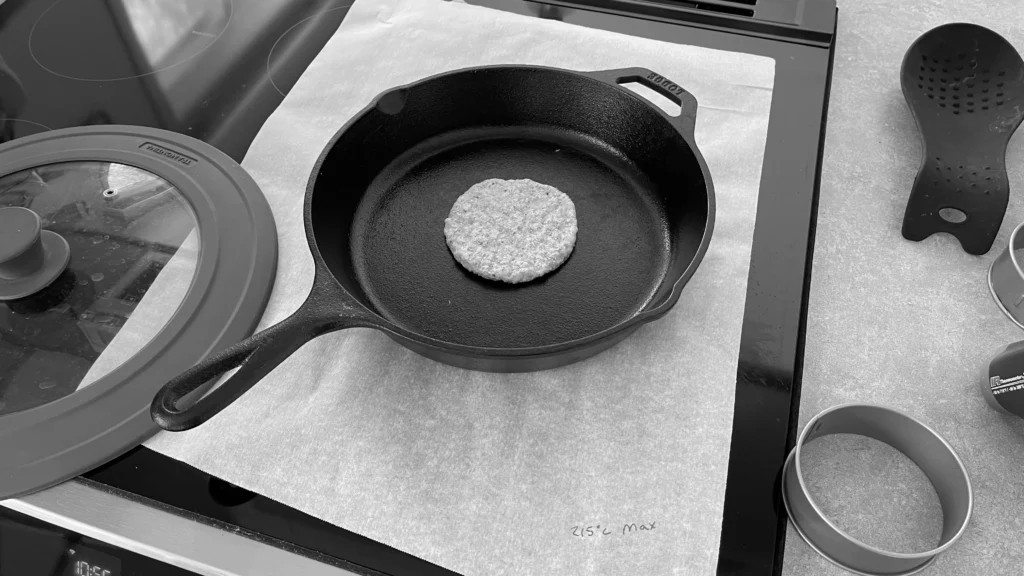
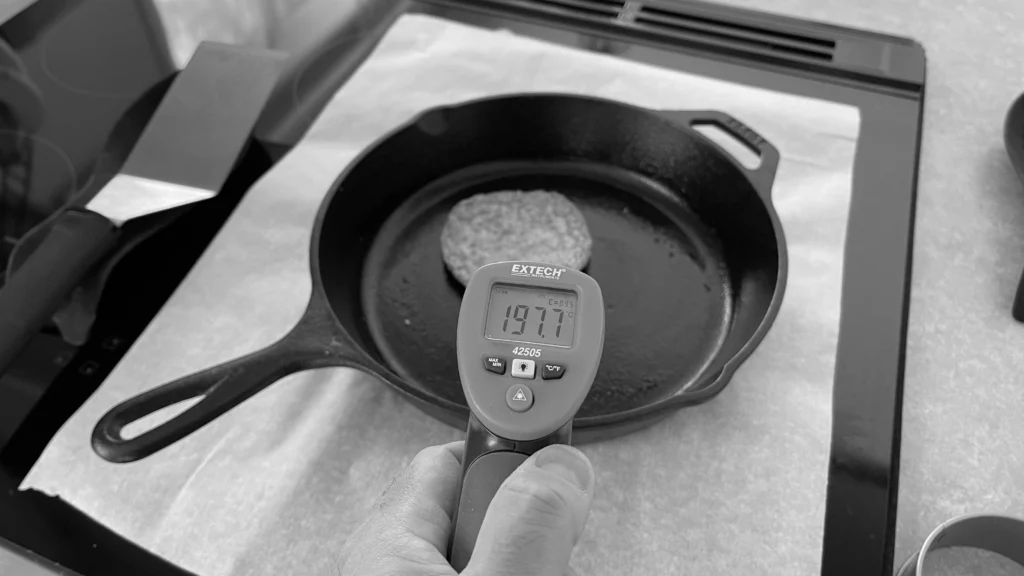
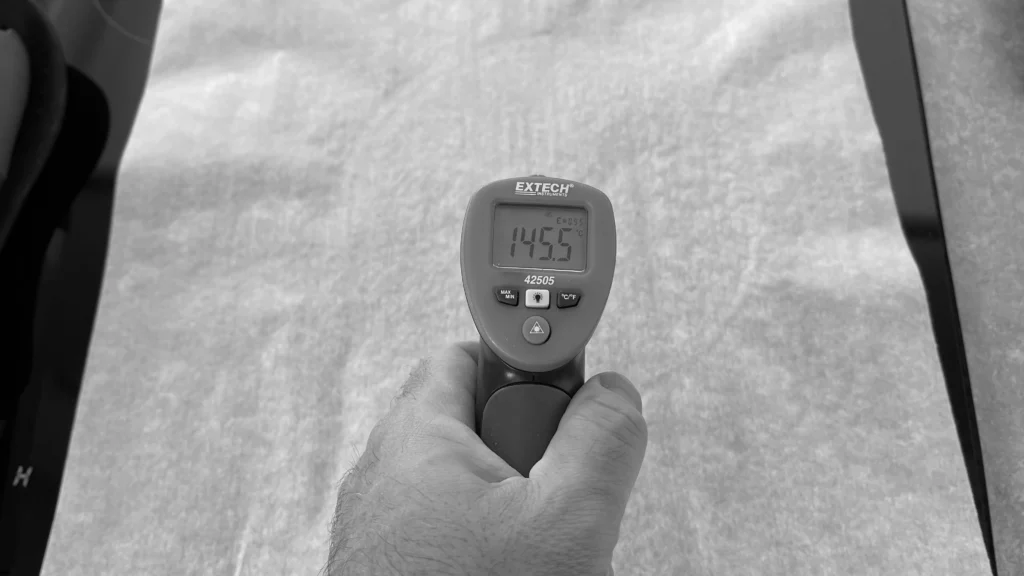
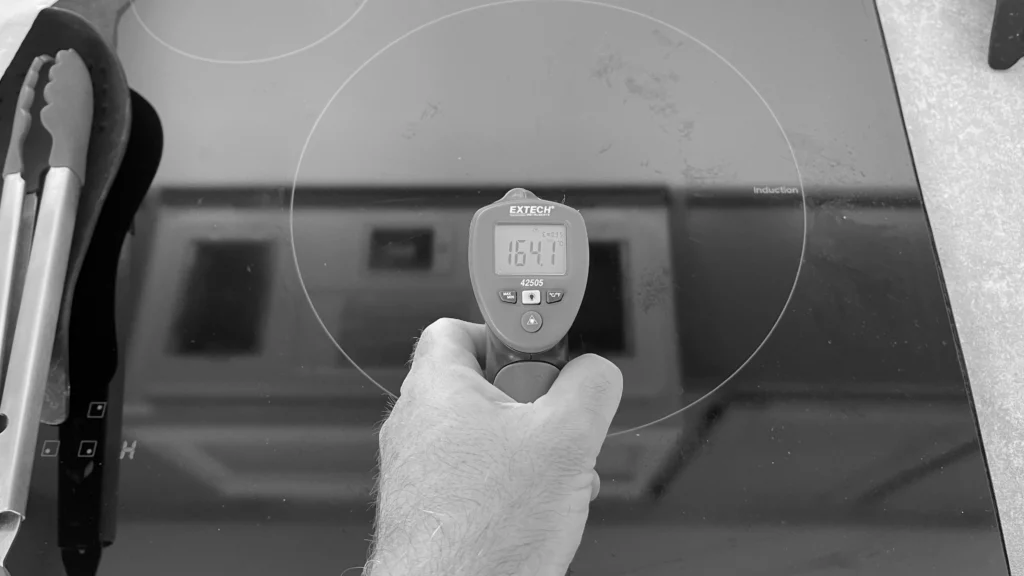
Air Fryer and the Convection Oven
The air fryer works well in this range. The range includes an air-frying metal grate to place vegetables, potatoes, or meat under the air fryer. Food cooks well with this method. Breaded fish turns out especially well.
The convection fan can be selected. This fan moves the air around in the oven. Foods cook more evenly, and the times to cook are faster. The convection mode can save time or allow the user to lower the cooking temperature.
Required Essentials
KitchenAid Silicone Stainless Steel Tongs, 10.26 Inch, Red (Sponsored Link)
